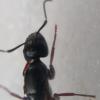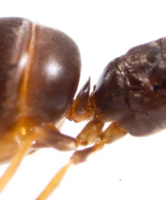This gem was collected sometime near the end of July to mid August. Sorry I cannot be more specific; I am going on the recollection of an 11 y/o. I just recently found out (2 days ago) about this queen, in a test tube set-up, hiding under his bed. He says she has been undisturbed. He placed the test tube in a box and secured it to the box with some blue tack. She has been in captivity for at least 2 months and has yet to lay eggs. Here is the information he is able to give us:
- Caught in our yard, near the cement/grass line
- Late July to mid-august
- Urban Grassy
- 8mm
- reddish-brown with lighter striations on gastor




Edited by FightNFive, October 8 2020 - 5:39 AM.





















